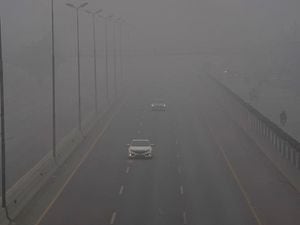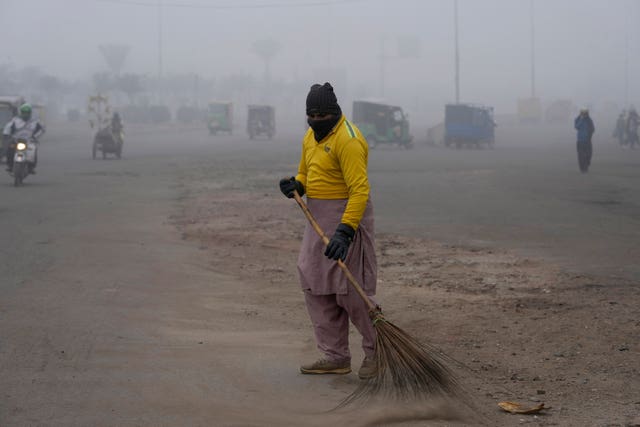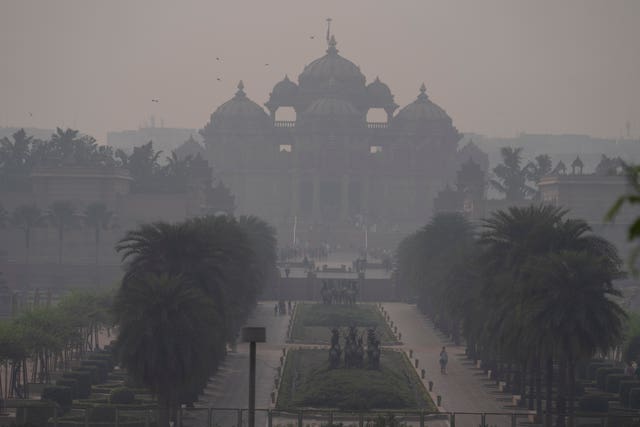Toxic smog which shrouds Lahore poses cross-border challenge in South Asia
Experts estimate more than 1.5 billion people are exposed to high concentrations of air pollution in Pakistan and India alone.

The air smells burnt in Lahore, a city in Pakistan’s east that used to be famous for its gardens but has become infamous for its terrible air quality.
Toxic smog has caused ill health among tens of thousands of people in recent months as Lahore sits in an airshed – an area where pollutants from industry, transport and other human activities get trapped because of local weather and topography so they cannot disperse easily.
Artificial rain was deployed in December to battle the smog – a national first for the technique – but nothing seems to be working.
Airsheds also contribute to cross-border pollution. Under certain wind conditions, 30% of pollution in the Indian capital New Delhi can come from Pakistan’s Punjab province, where Lahore is the capital.
There are six major airsheds in South Asia, home to many of the world’s worst polluted cities.

But that is a tall order when political relations in the region are fraught.
Ties between India and Pakistan are broken, their interactions riddled with animosity and suspicion.
Travel restrictions and hostile bureaucracies largely keep people from crossing the border for leisure, study and work, although the countries make exceptions for religious pilgrimages.
Pakistani analyst Abid Suleri, from the Sustainable Development Policy Institute, said: “There’s a recognition among the technical and scientific community that air pollution doesn’t need a visa to travel across borders.”
The culprits and problems are the same on both sides of the India-Pakistan border, he said, so it makes no sense for one province to implement measures if a neighbouring province across the border is not adopting the same practices.

“Airshed management needs a regional plan,” he said. “But 2024 is an election year in India and Pakistan, and government-to-government co-operation hasn’t reached that level.”
Pakistan is weeks away from voting in national parliamentary elections. So far, only the former foreign minister and political party leader Bilawal Bhutto Zardari has pledged heavy investment in climate adaptability, following record-breaking floods that killed more than 1,700 people.
In India, air pollution does not figure as a core issue that people would vote on, said Bhargav Krishna, a fellow at the New Delhi-based Sustainable Futures Collaborative think-tank.
But the experience or impact of climate change could make people think about how they vote.
Mr Krishna said regional elections sometimes see air pollution-related promises. “It was a feature of every party’s election manifesto in the New Delhi elections in 2020,” he noted.

The global body said almost 93% of Pakistanis are exposed to severe pollution levels. In India, it is 96% of the population. That means more than 1.5 billion people are exposed to high concentrations of air pollution in these two countries alone. It estimates around 220,000 deaths a year in Pakistan’s Punjab can be attributed to causes related to poor air.
Gray haze hangs pall-like over Punjab’s homes, mosques, schools, streets and farmland. There are 6.7 million vehicles on Lahore’s roads every day, and construction, emissions and waste are rife. There is scant visibility at major road junctions after dark, and smog shrouds landmarks like the Mughal-era Badshahi Mosque.
Pulmonologist Dr Khawar Abbas Chaudhry laments the deterioration of Lahore, which he describes as a “once beautiful” city. The hospital where he works is part of the Bill Gates-backed Evercare Group that has hospitals in the region, including India and Bangladesh, and in east Africa.

There are forums within Evercare to discuss issues like air pollution, and he and colleagues, including those from India, talk about the health impact of smog. But this dialogue is only happening within one institution.
“Countries, governments, departments need to be involved,” said Dr Chaudhry. “They need to meet regularly. Ultimately, people need to reach out and that could put some pressure on movers and shakers on both sides of the border.”
The director of Punjab’s Environment Protection Department, Syed Naseem Ur Rehman Shah, is proud of local achievements to fight air pollution.
He said emissions from industry and brick kilns are under control, farmers can soon buy subsidised machinery to end the menace of crop stubble burning, and there is a drive towards getting electric three-wheeled tuk-tuks, motorbikes and buses on the roads.
But although things are getting better, Mr Shah said it will take time.
That is of little consolation to Pakistani poet and former ambassador Ata ul Haq Qasmi, who is in Evercare for respiratory issues exacerbated by air pollution.
“If my friends aren’t in hospital, they should be,” he said. “You only have to step outside for it (the smog) to grab you.”
No comments:
Post a Comment